How To Do Hair In Photoshop

Selecting Hair with Refine Edge in Photoshop CS5
If in that location'due south ane thing every Photoshop user wants to know, it'south how to select someone's pilus in a photograph. In earlier versions of Photoshop, selecting pilus was the kind of thing that separated the pros from everyone else, requiring advanced knowledge of color channels, confusing commands like Calculations and Use Image, fancy blending options, and even painting individual strands of hair into the image by paw! It's no wonder almost Photoshop users avoided selecting pilus at all cost.
In Photoshop CS3, Adobe introduced the Refine Edge control, offering united states of america a first glimpse of how much easier it could be to select pilus, fur and other fine details in an image.
But in Photoshop CS5, Adobe gave the Refine Edge command a major overhaul, with enough improvements and new features to make selecting hair in a photo easy enough for anyone to do! Hairs... I mean, here'south, how to do it!
Here's the photo I'll exist starting with. Notice all the curly strands of hair sticking out in front of the gray background:

The original photo.
What I want to do is supersede that original greyness background with a different paradigm. If we look in my Layers panel, we see that I accept some other photo sitting on a layer below the original photograph. I'll click on the original photograph'due south visibility icon to temporarily turn the height layer off and so nosotros tin run into the paradigm on the layer below it:
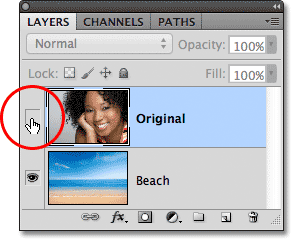
Clicking on the top layer's visibility icon.
With the top layer temporarily hidden from view in the document, we can see the paradigm I'll be replacing the background with:

The replacement background photo.
And hither's what the final upshot will look like thank you to the power of Photoshop CS5's Refine Edge command:
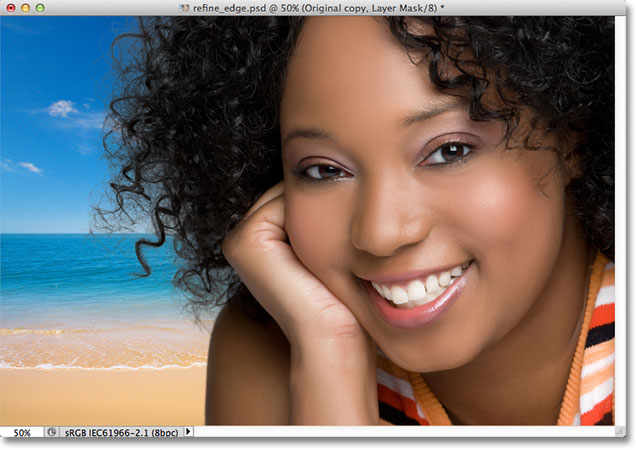
The last outcome.
This tutorial is part of our Portrait Retouching collection. Let'south get started!
Step ane: Draw A Crude Pick Outline Around Your Subject
I'm going to begin by drawing a fairly rough selection outline around the woman in the photograph. There's no need for any fancy or avant-garde selection tools here. Photoshop'southward standard Lasso Tool volition work fine, and the Polygonal Lasso Tool volition work fifty-fifty ameliorate considering it's faster and easier to use. I'll take hold of the Polygonal Lasso Tool from the Tools console past clicking and holding on the Lasso Tool, so selecting the Polygonal Lasso Tool from the fly-out carte:
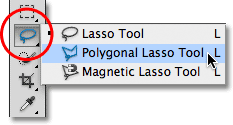
Selecting the Polygonal Lasso Tool.
With the Polygonal Lasso Tool in manus, I'll brainstorm by clicking effectually the woman's arm and shoulder in the lesser center area of the photo to lay down points for my selection outline. Observe that I'one thousand keeping my selection along the inner edge of her arm. The Refine Edge command tends to work best if y'all keep your initial selection just within the border of your field of study:
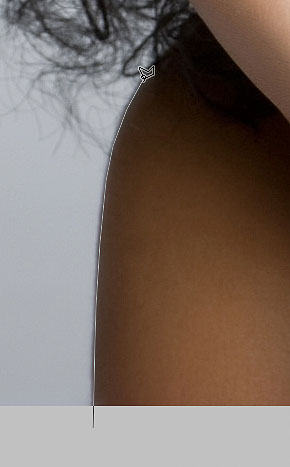
Clicking with the Polygonal Lasso Tool along the inner edge of her arm and shoulder.
As I move up into the woman's hair, I'll once more stay close to the edge but I'll make sure to avoid any areas where the grey background is showing through her hair. I just want to select the main surface area of hair for now, and I'll permit the Refine Edge command worry near the tough stuff in front of the background:

Keeping the selection outline abroad from areas where the background is showing through the hair.
Finally, I'll apace click in the pasteboard surface area around the image, then back on my original click point below her arm to complete my selection:
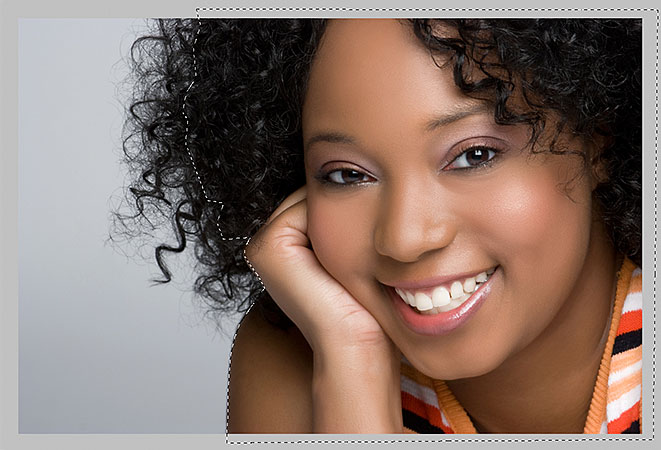
A rough selection outline now appears around the adult female in the photo.
Stride 2: Select The Refine Edge Command
With my initial selection in place, before I practice anything else, I'll make sure I take the correct layer selected in the Layers console. In my case, it's the top layer which contains the original photo:
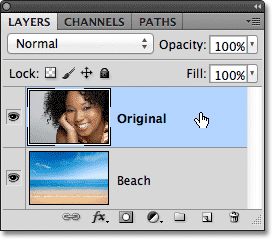
Making sure the correct layer is active (highlighted in blue).
So, I'll bring upwards Photoshop'due south Refine Border command either past going upward to the Select carte du jour in the Bill of fare Bar along the top of the screen and choosing Refine Edge from the menu choices, or, since I still have the Polygonal Lasso Tool selected, I can simply click on the Refine Border button in the Options Bar (you lot need to take a pick tool active for the Refine Border button to appear in the Options Bar):

Clicking on the Refine Border button in the Options Bar (with a option tool active).
This opens the Refine Border dialog box, only before nosotros expect at it, let'due south take a quick look at my epitome in the document window where nosotros see that the area I selected is now sitting in front of a solid white groundwork:
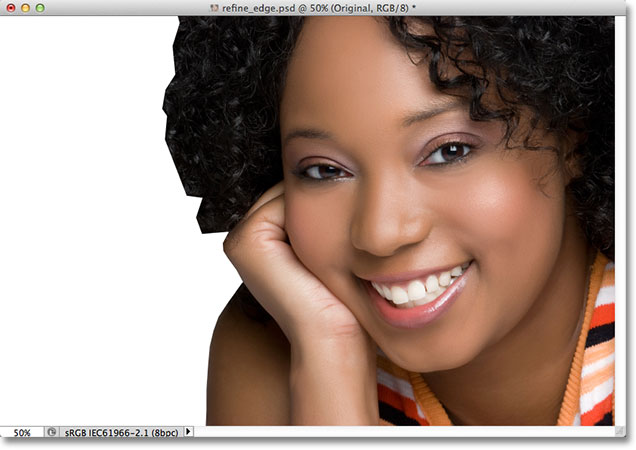
The document window showing the pick in front end of a white background.
The View Options
You lot may actually be seeing something unlike with your image. Your selection may be appearing in front end of a white background as mine is, or it may be in forepart of a solid black background. Or, y'all may notwithstanding be seeing the standard "marching ants" option outline, or several other possible views. Information technology all depends on which View Manner is currently selected at the top of the Refine Edge dialog box. You can see a small thumbnail preview of the current view mode to the correct of the word "View":
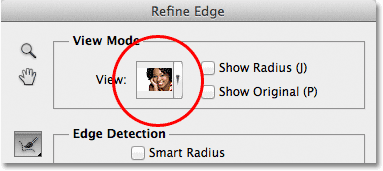
A small preview thumbnail shows the current view mode.
If yous click either on the thumbnail or on the pocket-sized arrow to the right of the thumbnail, you'll open up a list of the different view modes you can choose from. I currently accept the On White mode chosen, which is why my selection is appearing against a white background. I'll choose the On Black view mode directly above it:

Choosing the On Black view mode from the list.
And at present my selection appears against a solid black background:
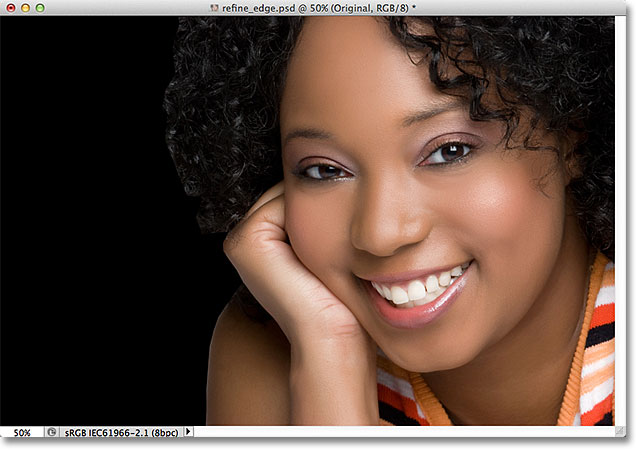
The pick now appears confronting black after choosing the On Black view way.
If I select the Black & White view manner from the list:
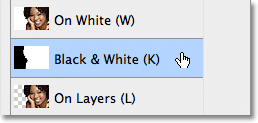
Choosing the Black & White view mode.
The epitome in the document window appears equally if I was looking at a layer mask. White represents the area that's currently selected, while blackness represents the area non currently selected. Any gray in the image would represent partially selected areas:
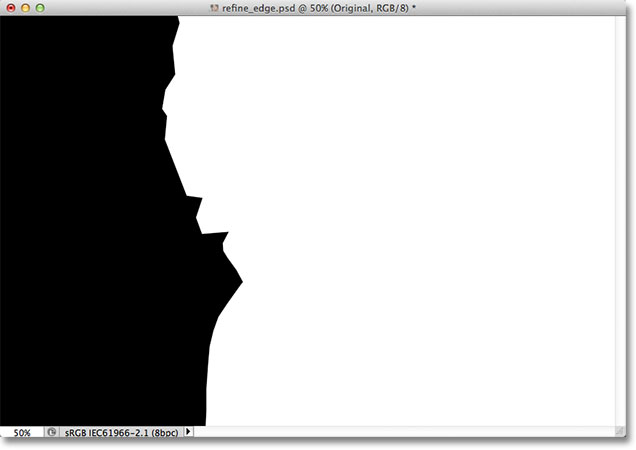
The Black & White view mode shows the image as it would announced as a layer mask.
Finally, I'll select the On Layers view manner:

Choosing the On Layers view mode from the list.
This fashion shows the electric current selection as information technology really appears in front of the other layer(s) in the document, which can be very useful when compositing images since it makes information technology piece of cake to judge the result. In my case, since I have a second photo on a layer beneath the main paradigm, we tin can see the second photograph behind my selection. If you're working on a unmarried-layer document with no other layers below your photo, the non-selected area volition be filled with a checkerboard pattern which is Photoshop's fashion of representing transparency:
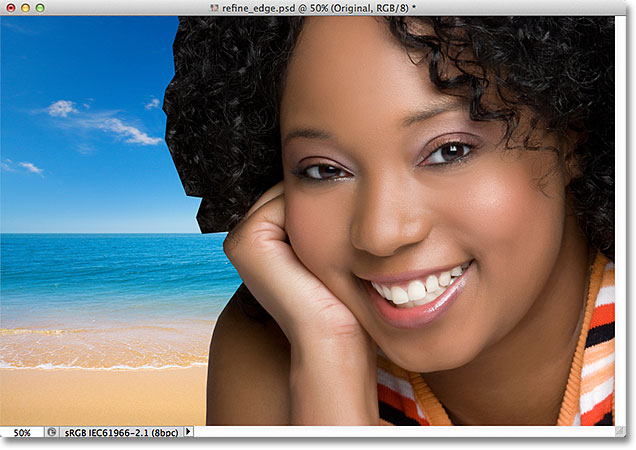
The image with the On Layers view mode selected.
I purposely skipped over the first two view modes - Marching Ants and Overlay - because neither of them is all that useful. The Marching Ants mode will show the standard selection outline, while the Overlay mode will display the non-selected expanse as a translucent red overlay similar to how the selection would appear in Quick Mask fashion. We'll look at the last view mode in the list - Reveal Layer - a bit later.
The purpose of these unlike view modes is to brand information technology easier for us to gauge our selection as we're refining it. With some images, the selection may be easier to see confronting white, others confronting black, and so on. Often, we'll demand to jump betwixt view modes equally we're working, which is why yous may take noticed that each of the view modes in the list has a letter to the right of its name. The letter of the alphabet is the keyboard shortcut for rapidly switching betwixt view modes, and they're handy to know. For instance, you tin can switch to the On White manner by pressing the letter W on your keyboard, the On Black style by pressing the letter B, the On Layers mode by pressing the letter L, and and so on. You can as well press the letter F repeatedly to bike between the view modes.
If you adopt to select your view modes from the list rather than with keyboard shortcuts, brand certain you double-click on the proper noun of the mode. This will select the view mode, then close out of the list.
Step three: Increase The Radius Value
Directly below the View Mode option in the Refine Edge dialog box is a section called Edge Detection. This, as they say, is where the magic happens. To add together more of the hair to your option, click on the Radius slider and begin dragging it towards the right:
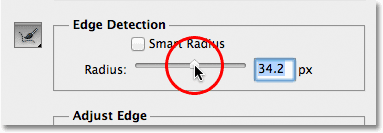
Click and elevate the Radius slider towards the correct.
As you elevate the slider, y'all'll encounter some of the hair that was outside of your initial selection get-go to announced. I'm using the On Layers view mode to make it easier to encounter the pilus as it will actually appear in front of my background epitome. You may be using a different view style:
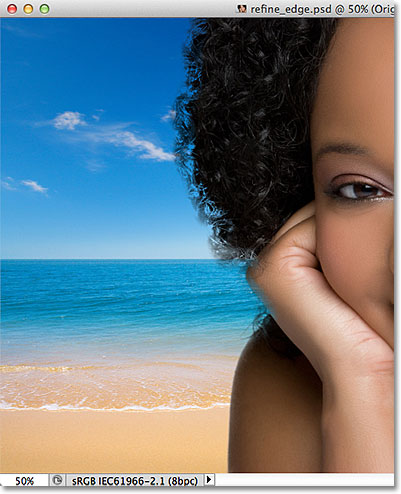
Some of the hair outside the initial choice is at present visible.
If I proceed dragging the slider to the correct to increase the Radius value:
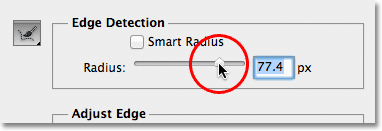
Dragging the Radius slider even further.
Then pilus even further away from my initial selection begins to appear:
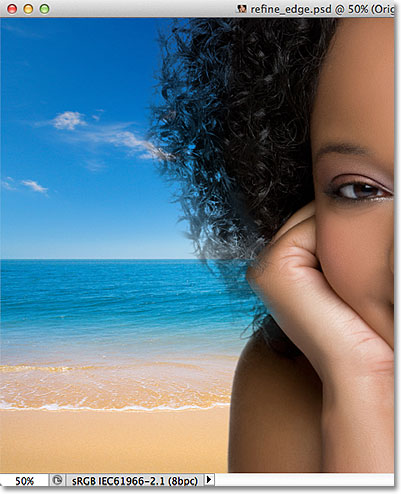
The image after increasing the Radius value.
And so what exactly is happening here? What does this Radius value have to do with selecting hair? If you expect to the right of the View Way preview thumbnail at the top of the dialog box, you'll see an choice called Show Radius which past default is turned off. Click inside its checkbox to plow it on:
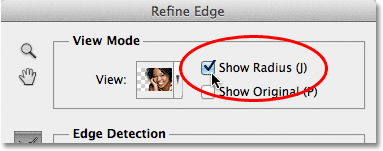
Selecting the Show Radius option.
With this option enabled, nosotros can actually see the radius in the document window. The way the Refine Border command works is that it looks around the edge of our initial selection to decide what else needs to be included in the selection, and the Radius value controls how far away from our initial option edge that Photoshop will look. It doesn't look across the unabridged prototype. It simply looks within the altitude we specify. That's why the Radius value is measured in pixels (px). If nosotros set the Radius value to, say, 50 pixels, Photoshop will look 50 pixels in either direction of our initial selection edge to determine if there'south anything else within this area that should be included in our choice.
If we look in my document window, we can see the radius every bit that visible zone between the two areas of solid blackness. The solid blackness represents areas that Photoshop is ignoring as it looks for additional pixels to add to our selection (with the On White view mode, the areas being ignored appear in white, not blackness). Only pixels within the radius zone are existence analyzed:
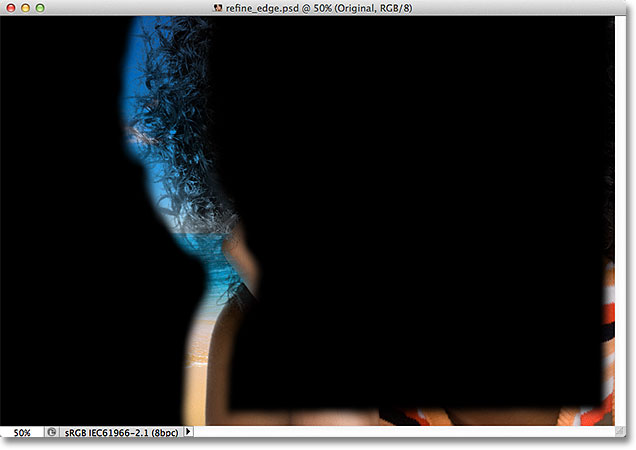
The Radius appears between the areas of solid black.
To make it easier to see, I'll printing the letter G on my keyboard to quickly jump from the On Layers view fashion to the Black & White view mode, and at present the radius zone appears as solid white between the black areas:
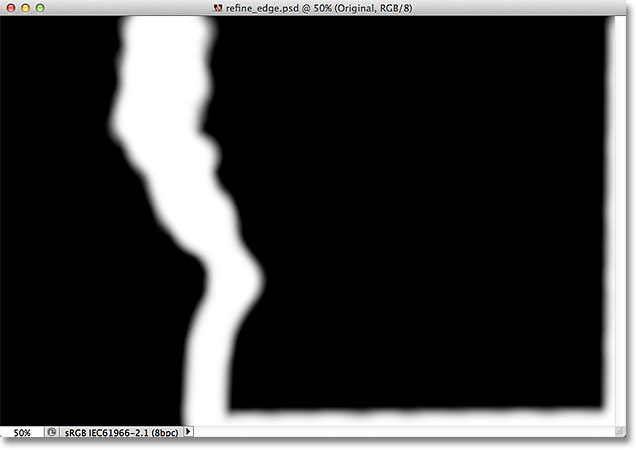
Viewing the radius using the Blackness & White view mode.
I'll switch back to the On Layers view fashion by pressing the letter Fifty on my keyboard.
Smart Radius
Increasing the Radius value has allowed me to fit more of the woman'southward hair into the zone that Photoshop is analyzing, which is corking, except that at the same time, it's not so neat considering it's causing potential problems in other areas. The radius is now too wide effectually the woman's arm and shoulder, and it's also actualization effectually the bottom and right edge of the image where I don't need it at all:
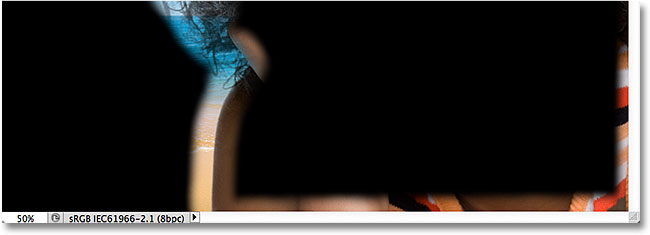
The hair needs a wide radius, but other areas do not.
This is where the Smart Radius option comes in. You'll observe it directly above the primary Radius slider. By default, Smart Radius is turned off. I'll click inside its checkbox to turn information technology on:
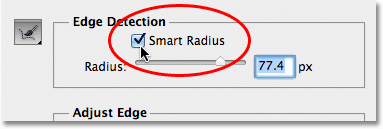
Turning on Smart Radius.
With Smart Radius enabled, Photoshop looks more closely along the edge of the initial selection and tries to tighten up the radius size wherever possible. In other words, with my image, the edge forth the adult female's arm and shoulder is shine, and then Photoshop will (hopefully, anyway) reduce the width of the radius in that area while still leaving a wider radius for the hair. If we await in my document window, we come across that Photoshop has done exactly that. I still accept a broad radius around the hair, merely the radius along the arm and shoulder is much more narrow. There's still a bit of unwanted radius along the bottom of the image, but we'll see how to make clean that up in a moment:
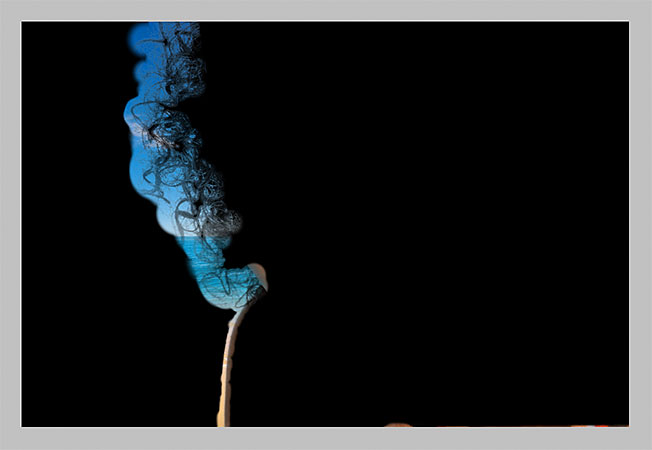
With Smart Radius turned on, Photoshop can adjust the width of the radius in unlike areas.
A quick note almost Smart Radius before we proceed. Depending on your paradigm and the blazon of edge you're working with, Smart Radius can help or it tin make things worse. A general guideline with Smart Radius is that it tends to help with selections that incorporate dissimilar types of edges, as in my case here. If, on the other hand, you're just selecting hair and cipher else, or just selecting polish edges and nix else, yous'll probably discover that y'all're better off leaving Smart Radius disabled. Of grade, it's piece of cake to select it and so make up one's mind if things look improve or worse, but don't think yous need to apply the option just considering it's there and it has "Smart" in the proper name. In that location are other ways to adapt the size of the radius, every bit nosotros're about to see!
Step 4: Manually Conform The Radius With The Refinement Brushes
Once we've washed all we can with the Radius slider and the Smart Radius option, we can then manually refine our radius using a couple of brushes that come with the Refine Edge command. If you lot wait to the left of the Radius and Smart Radius options, you'll see a castor icon. If you click and hold on the brush icon, a menu will announced where yous can select the brush you need. The two brushes we have to cull from are the Refine Radius Tool and the Erase Refinements Tool:

Click and agree on the brush icon to admission the radius refinement tools (brushes).
The names can be a fleck disruptive, then you may detect it helpful to call back of the Refine Radius Tool equally the Add to Radius brush and the Erase Refinements Tool equally the Subtract from Radius brush. Adobe calls them "Tools" but they bear exactly like brushes, allowing the states to only paint over the areas in the image where we need to add to, or subtract from, the existing radius.
By default, the Refine Radius Tool is already selected for u.s.a. considering that's the one we utilise the most, and so in that location'southward no need to actually select it from the list. There's besides no need to select the Erase Refinements Tool from the list because at any time, we tin can temporarily switch from the Refine Radius Tool to the Erase Refinements Tool just by pressing and holding the Alt (Win) / Choice (Mac) primal on the keyboard. When yous release the Alt / Option central, you lot'll switch dorsum to the Refine Radius Tool. In other words, you'll never need to select either tool from the dialog box, and then you tin safely forget all about that brush icon.
Before I try to add together more of the woman's pilus to my option, I'm kickoff going to use the Erase Refinements Tool to remove the unwanted radius area from the bottom of my prototype. Go on in mind equally you use these tools that dissimilar Photoshop'southward other option tools, nosotros're not adding to, or subtracting from, the bodily selection itself with these tools. We're simply adjusting the size of the surface area that Photoshop is analyzing. Photoshop determines which pixels to select and which to ignore. Nosotros're just telling it where to look and where non to await.
I'll hold down my Alt (Win) / Choice (Mac) key to temporarily switch from the Refine Radius Tool to the Erase Refinements Tool. It'southward a bit difficult to see in the screenshot, merely a small minus sign (-) appears in the center of the brush cursor when the Erase Refinements Tool is active (a plus sign (+) appears when the Refine Radius Tool is active). Then I'll simply click and elevate over the unwanted radius areas to erase them. Since I withal have the Show Radius option selected at the top of the dialog box, we can see that the area along the bottom of the paradigm is now filled with solid black, which ways Photoshop will at present ignore that area:

Holding down Alt (Win) / Pick (Mac) and painting forth the lesser of the image.
I'll release my Alt (Win) / Option (Mac) primal to switch dorsum to the Refine Radius Tool so I can start adding more of the woman's hair to my selection. I'm going to uncheck the Show Radius pick at the top of the dialog box then nosotros can once again see the bodily photo in front of the groundwork image (using the On Layers view mode):
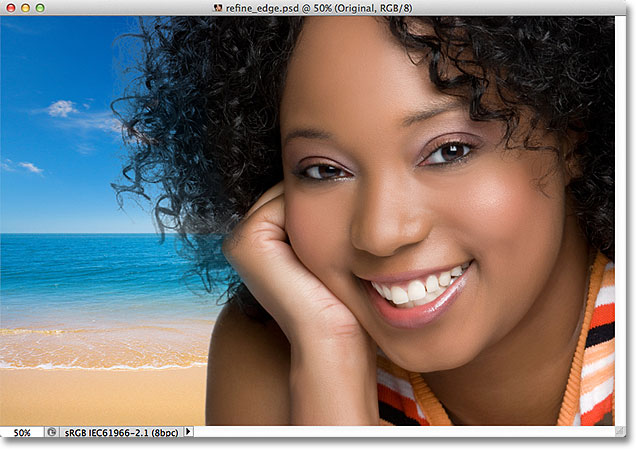
With Show Radius turned off, we switch back to seeing the image in the document window.
To add more of the woman's hair, I just need to paint with the Refine Radius Tool over the expanse where her hair should exist. Merely how practice I know where to paint when I can't actually see the rest of her hair because it's not currently part of the pick? It would be helpful if at that place was some mode to temporarily view the entire original image so I can run into exactly where I should be painting. Thankfully, another of the Refine Border view modes - Reveal Layer - let'due south us exercise exactly that!
I'll click on the view mode thumbnail at the elevation of the dialog box, and then I'll double-click on Reveal Layer at the lesser of the list to select information technology. I could also quickly select the Reveal Layer mode by pressing the letter R on my keyboard:
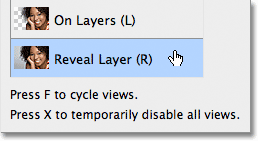
Choosing Reveal Layer from the bottom of the list of view modes.
With the Reveal Layer view mode agile, the original image returns in the document window, making it piece of cake to see where I demand to paint with the Refine Radius Tool:

Reveal Layer shows the original epitome without whatsoever selections.
Now that I know where to pigment, I'll press the letter of the alphabet L on my keyboard to switch back to the On Layers view way, then I'll begin painting with the Refine Radius Tool to reveal more than of the woman'south hair. Just like any of Photoshop's other brushes, nosotros tin can change the size of both the Refine Radius Tool and the Erase Refinements Tool directly from the keyboard. Pressing the left subclass key ( [ ) will brand the brush smaller, while the right bracket fundamental ( ] ) will go far larger.
As y'all're painting over the area with your mouse push held down, you'll come across the original image appearing inside the surface area where you've painted, which helps us to see that we're painting in the correct spot:
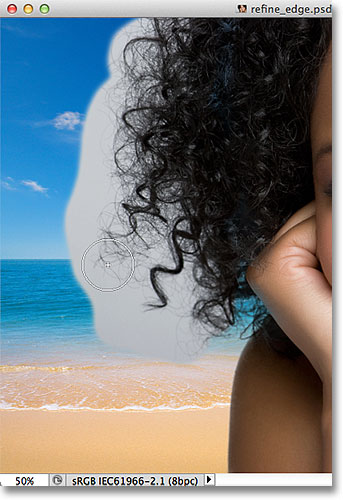
The gray background from the original image is visible while my mouse button is held down.
When you release your mouse push button, the original image disappears and nosotros see the result, with more of the hair added to the selection. Yous can continue painting over the hair with the Refine Radius Tool to add more of it to the selection, or, if you make a fault, printing and hold the Alt (Win) / Pick (Mac) cardinal to switch to the Erase Refinements Tool and pigment to remove that area from the radius zone:
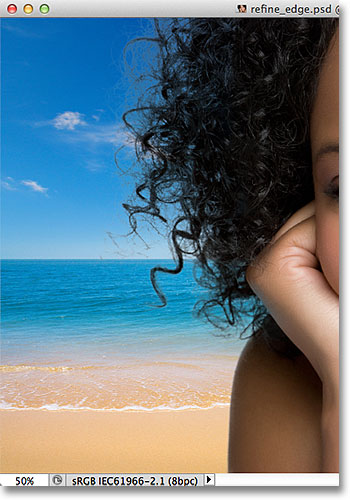
More of the woman's hair now appears in front of the new background after painting with the Refine Radius Tool.
The Arrange Edge Options
Below the Edge Detection options in the Refine Edge dialog box are the Adjust Edge options - Shine, Feather, Contrast, and Shift Border. All four of these options are gear up to 0 by default and when using the Refine Edge control for selecting hair, it's usually best to leave at least the first three options (Smooth, Feather and Contrast) set to 0. The Smooth pick is used for smoothing out jagged selection edges, only it usually causes problems when selecting hair. The Plumage option will blur the selection border which merely makes things expect soft, blurry and unprofessional. And the Contrast option will effort to sharpen upwards selection edges by boosting contrast, again not something that ordinarily works well with hair.
The only option yous should try is the fourth one, Shift Edge. Dragging the slider to the right of center will expand your selection edges outward, which may assistance to add more hair to the selection, while dragging the slider to the left of heart will contract the pick edges inward, tightening up the selection. If neither management helps to improve your results, simply drag the slider back to middle. In my instance, I'm going to drag the slider to the right to increase the Shift Edge value to +twenty%:
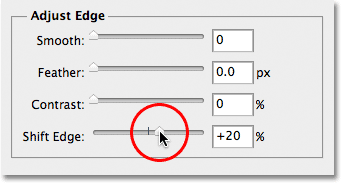
Increasing the Shift Edge value to aggrandize the selection edge outward.
This expands my selection edges outward and I at present encounter more fine hair detail being added to the option, although much of it looks very faded at the moment, but nosotros'll fix that next:
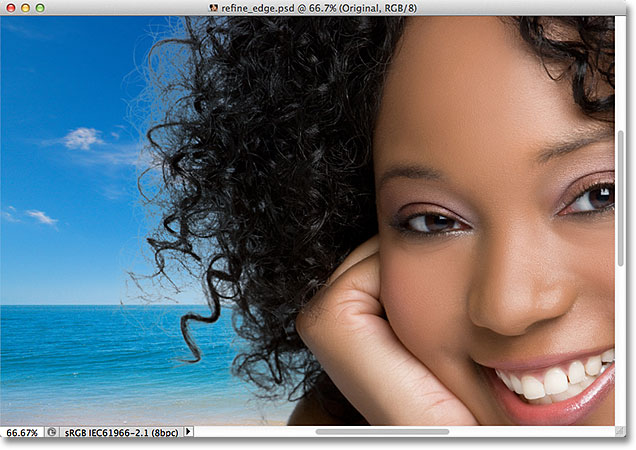
Increasing the Shift Edge option added additional hair detail to the image.
Step 5: Remove Whatsoever Fringing Past Decontaminating The Colors
Things are looking skilful except for one remaining problem. Nosotros're seeing a lot of fringing effectually the pilus, which is remaining colour from the original background. We tin remove the fringing using the Decontaminate Colors option, found in the Output department at the lesser of the dialog box. Past default, Decontaminate Colors is turned off. I'll click inside its checkbox to plow it on:
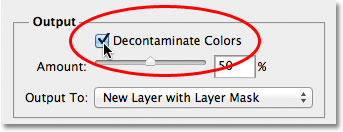
Selecting the Decontaminate Colors pick.
I tin now make clean upward the fringing by dragging the Amount slider towards the right. The default Amount value is l%. Equally yous drag the slider further to the right, Photoshop removes the fringing by physically changing the color of the pixels around the hair so that they friction match the color of the hair itself rather than the original groundwork color. I'll increase my Amount value to 75%:
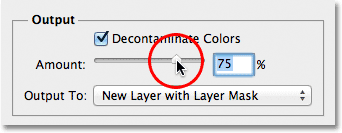
Increment the Decontaminate Colors amount to remove fringing around the hair.
The hair now appears darker, especially the finer strands that were originally light grayness, and the fringing has been removed:
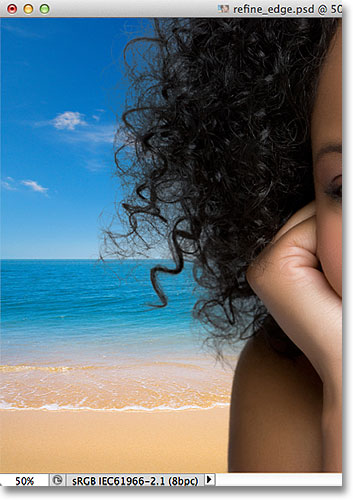
The epitome after removing the fringing with the Decontaminate Colors option.
Step 6: Output The Choice
At present that we're done selecting the hair, we need to output our pick, and the best manner to exercise that is to have Photoshop convert our selection into a layer mask so that we're non really deleting any pixels from the original prototype. Set the Output To option, which you'll observe directly below the Decontaminate Colors pick, to New Layer with Layer Mask if information technology isn't set to that already:

Selecting "New Layer with Layer Mask" for the Output To pick.
Click OK in the lesser right corner of the Refine Edge dialog box to close out of it. If we expect in my Layers panel, nosotros see that Photoshop has made a copy of my original image and converted my option into a layer mask on the new layer. The original layer below it has been turned off and so it's no longer visible in the document window:

The Layers panel showing the layer mask on a copy of the original image.
Stride 7: Make clean Upward The Layer Mask If Needed
Since we focused and so much on selecting the hair in the image, there may be some other parts of the selection that demand a bit of cleaning upwards. To audit the layer mask for any problem areas, press and hold your Alt (Win) / Option (Mac) primal on your keyboard and click directly on the layer mask thumbnail in the Layers panel:
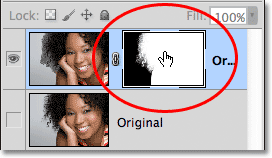
Concord downwardly Alt (Win) / Selection (Mac) and click on the layer mask thumbnail.
This both selects the layer mask and makes it visible in the document window. If you observe any areas that need to be touched upwardly, grab Photoshop'southward standard Castor Tool from the Tools panel and paint over the areas with either white or black equally needed:

Painting with white (using the standard Brush Tool) to clean upwardly a few areas of the mask.
When you're done, switch back to the normal image view in the certificate window past clicking on the layer's preview thumbnail in the Layers panel:
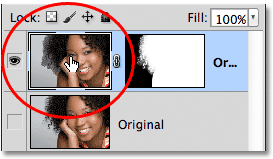
Clicking on the preview thumbnail to the left of the mask thumbnail.
And here, later on a quick touch up of the layer mask, is my final result:

The last result.
And at that place we take it! That'south how to select hair in a photo using the powerful Refine Edge control in Photoshop CS5! For more than about Photoshop choice tools, see our How to make selections in Photoshop series. Or visit our Photoshop Basics section for more Photoshop topics!
Other Stuff
© 2022 Photoshop Essentials.com.
For inspiration, non duplication.
Site design by Steve Patterson.
Photoshop is a trademark of Adobe Systems Inc.
Source: https://www.photoshopessentials.com/photo-editing/selecting-hair/
Posted by: johnsonfrony1967.blogspot.com

0 Response to "How To Do Hair In Photoshop"
Post a Comment